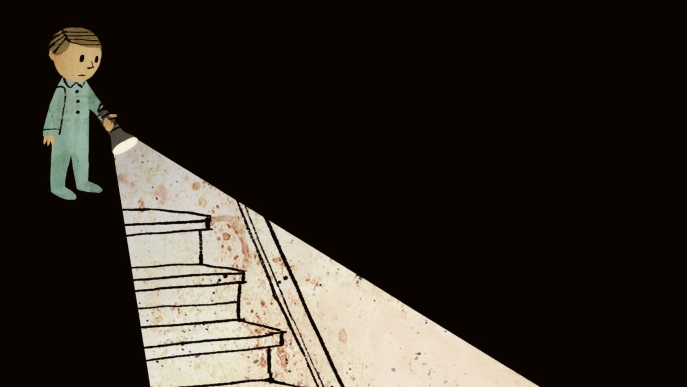How Free Book Trailers Can Be Used To Inspire Reading and Writing

Dramatic, accessible and best of all free, book trailers can be used by the cunning teacher to inspire reading, writing and oracy, says Rachel Clarke…

- by Rachel Clarke
- Experienced educator, consultant and writer specialising in primary English Visit website

As readers, books are gifts in which to lose ourselves. As teachers, they’re a medium for teaching the reading and writing curriculum, and for inspiring a love of reading. But to publishers they are also a commodity to be marketed to consumers such as you and me. This is where the book trailer comes in.
These short, animated adverts for books are designed to part us from our hard-earned cash, but they’re also free resources with which to inspire children’s reading, writing, speaking and listening.
How to read book trailers
First off, ‘reading’ multi-modal texts such as book trailers isn’t really any different to reading prose, so don’t feel as though you have anything to lose by giving it a go. All that’s different is that some of the evidence comes from the images, audio and choice of fonts used in the trailer. When reading for meaning, there are three main questions I like to use with children:
When reading for meaning, there are three main questions I like to use with children:
- What do we know? (retrieval)
- How do we know this? (finding the evidence)
- What do we think we know? (inference and deduction)
A quick glance at any book trailer will show that these questions are still pertinent, even though a book hasn’t been opened to this point. Book trailers are a visual blurb: a taste of what a book is about that leaves the reader desperate to know more . which is precisely why the three basic questions work so well.
Have a go at watching this book trailer for The Dark, by Lemony Snicket and ask yourself the three questions above.
Doing this immediately after a single viewing with children could be tricky, so consider asking them to watch the trailer through once just to get a sense of the narrative. Then provide them with questions one and two so they can watch again with focus. Finally, watch the trailer again with question three in mind. Give them time to talk to a partner about what they have seen and then collect their responses. This is a great way to introduce book trailers to children in KS1 and lower KS2.
Find puzzles and patterns
With book trailers working like blurbs, the questions ‘What happens next?’ and ‘Why do you think this?’ arise naturally when the trailer has finished. But whilst these are great questions, using Aiden Chambers’ Tell Me structure (likes, dislikes, puzzles and patterns) with multi-modal texts takes things a step further, helping children to infer the different messages being conveyed.
Once accustomed to this way of working, children become adept at the two challenging aspects – ‘puzzles’ and ‘problems’ – and when watching a book trailer such as The Wildwood, by Colin Meloy, we can see how Chambers’ structure comes into its own.
I’m personally puzzled by the baby in the wilderness, and in terms of patterns I’m intrigued by the sinister use of silhouetted wolves, crows, and the stark warnings of the narrator, all of which signal to me that this is not a good place to be. By looking for puzzles and patterns I’m drawing on my existing knowledge of texts and stories, and working at a deep cognitive level.
Stimulate writing
Writing and reading are two sides of the same coin. This is why we use texts as models of What a Good One Looks Like (WAGOLL). Many book trailers (particularly those for animated fiction) are gently evocative or lightly humorous films that quietly persuade us to read – see Oh No, George! by Chris Haughton (tinyurl.com/tpgeorge).
Others employ many more of the obvious marketing techniques that we want children to master in their writing of persuasive texts. A single viewing of the book trailer for Rick Riordan’s The Throne of Fire is enough to realise that this is a hard-sell advert.
It’s just like going to the movies. This trailer is incredibly short, but leaves you in no doubt that the book is a tour de force. Pulling out all of the persuasive techniques requires teamwork, so consider dividing children into pairs: one to listen to the book trailer, the other to watch.
Ask them to make notes and then swap roles. They should be able to identify the strong voice, rousing music, and swooshes and explosions that mark this out as an action adventure. They should also be able to note the product placement making it clear this is a book advert and not a movie. It would be interesting to see if they could identify the target audience.
Getting them to explain why will reveal sophisticated depths of inference and awareness of the multi-modal world in which they live, and their ability to make links across written and visual texts.
Story starters
Ideally we want to use book trailers to inspire children to read the books they advertise. But there’s no reason why this should be the only way we use them. Many schools have a weekly writing lesson stimulated by an object, image or excerpt of text. Book trailers can be used in exactly the same way. Just take a look at The Thickety as a potential scary story starter for Y5 and Y6 children; and in contrast The Journey as an adventure story starter.
Both trailers leave the viewer with plenty of unanswered questions that should provide sufficient inspiration for a class set of fabulous narratives. Of course, reading the book afterwards, or having it available for inquisitive children to read, is the perfect conclusion to using book trailers in this way.
Make your own book trailers
I’m not the most technologically minded teacher, but I have used Photostory with some success and think it’s a particularly manageable and effective way for children to make their own book trailers. If you’ve not used Photostory before, I recommend taking a look at this website, where you’ll find some examples of pupil-made book trailers and a simple tutorial for technologically nervous practitioners.
Animoto is also worth checking out, and this YouTube video provides an easy-to-follow tutorial for making your own book trailers.
Once you’ve fathomed out how to make a book trailer, you’re ready to help your class make their own. Why not start by watching a few official publishers’ book trailers and deciding which features the good ones contain. Then set the children off to make their own book trailers – you’ll never have to read a half-hearted book review again!
People who also viewed this liked…
All of the major publishing houses have YouTube channels promoting their children’s book trailers. Consider bookmarking the YouTube channels for HarperKids and Random House Kids, as well as this videos page at the Simon & Schuster website.
I’ve also collected book trailers from around the web and curated them via a Pinterest board.
If using book trailers takes off in your school, consider all the different creative ways in which they can be used:
- Show them in the library as a way of advertising stock
- Embed the trailer for your current or next class-reader into your class web page or blog
- Use book trailers to promote the books featuring in your next whole-school reading event
- Flip learning by asking children to watch the trailer for homework before starting work on the text in class







